One of the most common misconceptions about programmatic is that it’s unsafe.
Sure, there have been some notorious cases of ad misplacement over the past few years. And it can be pretty embarrassing (or worse) when it happens.
Machines are doing most of the buying and running of digital ads, which is is amazing. But sometimes extra safeguards and human oversight are needed.
The inconvenient truth is: fighting ad fraud is hard.
Most advertisers like the prospect of increases their reach, but that comes at the cost of brand risk. It’s up to them to decide how exactly they want to balance brand safety and reach.
No media buyer can guarantee complete brand safety, nor can they ensure that every single impression is from a real person rather than a bot. A percentage of any digital advertising spend, at least for the foreseeable future, will either be wasted on non-human traffic or served on inappropriate sites.
But what we can do is fight tooth and nail for brand safety with a strict measures, and share our best practice in the interests of complete transparency.
Step 1: DV360 default policies
We use one DSP and one ad server. This means we spend less time on making deals and more time optimising our accounts (e.g. ad misplacement strategy), while still giving us more than enough reach.
Google doesn’t run ads on webpages that violate their policies. Anyone who uses Display & Video 360 (DV360) gains this first layer of protection.
Step 2: Additional DV360 settings
DV360 has additional safety controls that allows us to block content based on their brand safety labels, as well as by sensitive categories like Alcohol and Tobacco.
We always encourage clients to choose the maximum safety settings. There’s a wealth of inventory out there, and excluding certain categories based on their subject matter isn’t going to prevent you from getting the reach you need.
Step 3: Our own blocklists
Alongside the efficiency of automation, there will always be a need for a bit of common sense. The third layer of protection comes from our own agency-wide site and keyword lists, plus any extras from clients.
Our programmatic team proactively updates our site and keyword blocklists whenever something unsuitable emerges to prevent any bids from being placed.
Step 4: DoubleVerify
DoubleVerify is one of the rare third-party tools we use at Brainlabs. DoubleVerify checks every site pre-bid to make sure we don’t waste a single impression on an inappropriate site.
It also monitors every ad served post-bid, providing metrics on viewability, impressions, quality, category, and also domain classification. We can then manually optimise using this post-bid data on a website-level. If a site starts to behave irregularly, it gets flagged, investigated, and then, if necessary, the ad is removed.
Step 5: Ongoing internal verification
Relentless vigilance is an essential part of this process.
After a campaign is live, we manually vet sites, create daily reports and consult frequently with DoubleVerify and DV360. The final step is ongoing because new domains are created every day, suppliers change their strategies, government regulation changes, and new tools become available. It’s our job to stay on top of this.
Step 6: Safelist of known and trusted sites
This isn’t necessary for all advertisers, but for our most brand-safety conscious clients, we only run on an agreed whitelist of sites. This works on a case-by-case basis depending on their priorities, as this does have an effect on the available inventory. On the upside, we get a guarantee of total control of where we are serving ads.



